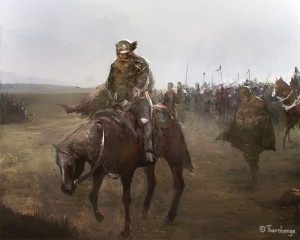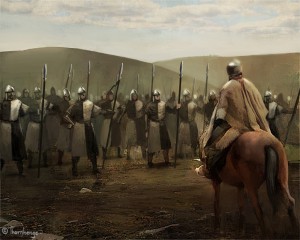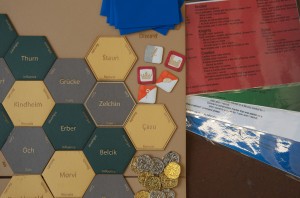One of the most gratifying things about making a game is seeing all the ideas that have been stuck in your head for weeks, months, or years make it out into the world. Seeing professional art – not just your imagination – makes the game suddenly real. For Lyssan, I have the honor of working with the exceptionally talented and creative Marek Madej.
The world of Lyssan is one I’ve had in my head for years now, so the cards all have stories behind them. Many of them feature characters that I’ve already explored in other, unpublished games, who have never seen a wider audience before. The first challenge is to take all this and pack it down to a short description – one that hits the essential points, and gives Marek plenty of room to play.
For the card “The Brothers of Garus”, the write-up looked like this:
Card Name: The Brothers of Garus
My image for the card: A crusader-knight wears armor covered in religious symbols. We see him at the moment of a hasty salute as he charges into battle.
What this card does in the game:This card a vassal that supplies the player with new Knights and Priests
Aspect ratio: Portait 1×2
Notes: This is another vassal card – a card representing an alliance with a powerful faction in the game. The Brothers of Garus are a militant faction within the Church of Alor. Their name is taken from Saint Garus, formerly named General Garus. According to legend, he was sainted after personally defeating the demonic general of an evil army that threatened to destroy the old empire. It is thought that the Brothers of Garus might be cast out of the church as heretics, if some orthodox priests of Alor gain power. It is said that they worship their saint above the creator, and would make all do so if they grew strong enough to try. Reminder: The church of Alor is inspired by the historical Catholic church, but they’re fictional. They have their own symbols in place of the crucifix, fish, and so on. Feel free to invent a few of these symbols.
Whew. That’s a wordy one. Not long after, Marek gets back to me with four thumbnail sketches for this image, along with the rest from this batch of images. They look like this:
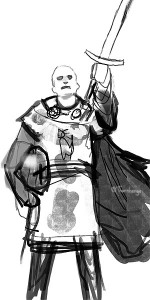
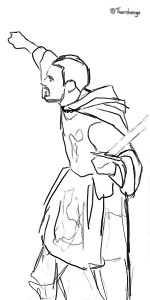
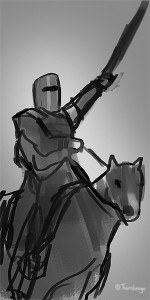
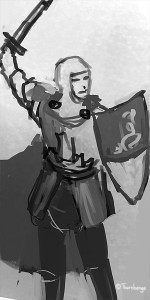
Marek has his own commentary on the images at this stage, and it reads like this:
The Brothers of Garus
01 – The first one… is maybe not looking like hasty salute, but I just thinked that significant version can also looks nice.
02 -The second one is my favourite.
03- I didn’t know… there wasn’t any informations about horse in this one, but… I’ve done also version with a horse.
04 – The pose in this one looks too stiff
At this stage I’m looking over the thumbnails for a favorite, but I’m also looking for any problems. It could be something that would be an anachronism in the world, or something that doesn’t fit the storyline, or something in the image that’s going to take emphasis away from the part that should be the focus for the game. In this case, they all look good, and Marek has indicated he has a favorite. I’d be a fool not to let him chase his muse. He gets the go ahead to continue with that one.
Over the next few days, the images from this batch come in, in first draft mode. Marek is giving me a chance to make any last-minute corrections to the images focus, lighting, or details. At this point, the roughed-in version of The Brothers of Garus looks like this:
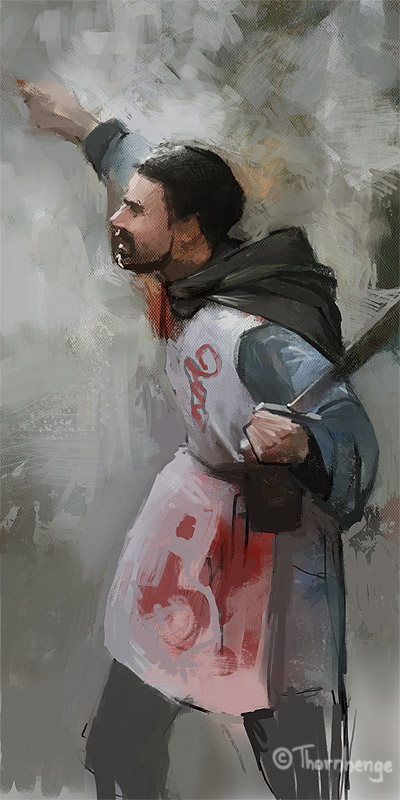 I’ve got no corrections or complaints. It’s shaping up to be a fine image, and one that captures the spirit of the card. Before diving into finishing this image, Marek brainstorms a quick dozen symbols that might be on the knight’s tabard. Now everything that happened before it fun enough, but this stage is a bonus. All the while, the world of Lyssan has been in my head. What it looks like has been a one-way flow from me to Marek to you. Now I get to look at his ideas for symbols, and figure out which one fits into Lyssan’s story. In the end, I pick the ninth symbol from his brainstorm, reasoning that:
I’ve got no corrections or complaints. It’s shaping up to be a fine image, and one that captures the spirit of the card. Before diving into finishing this image, Marek brainstorms a quick dozen symbols that might be on the knight’s tabard. Now everything that happened before it fun enough, but this stage is a bonus. All the while, the world of Lyssan has been in my head. What it looks like has been a one-way flow from me to Marek to you. Now I get to look at his ideas for symbols, and figure out which one fits into Lyssan’s story. In the end, I pick the ninth symbol from his brainstorm, reasoning that:
9 is a version of General Garus’ personal Coat of Arms, as seen on his shield when he was alive. It’s been simplified over the years by the church to resemble the symbol of Alor – the three dots were originally heraldic devices like a ‘lion rampant’ or somesuch. The three lines are the dividing fields of the shield, where it was originally split into three fields. In the 200 years since Garus’ death, the story of Saint Garus has grown, so now a visitor to the church is more likely to hear that the central T represents Garus himself and the three dots are his loyal Corporals, or some other corruption of the original meaning of the symbol that makes it seem more grand.
And it’s not long after that when Marek finishes the final version of the image.
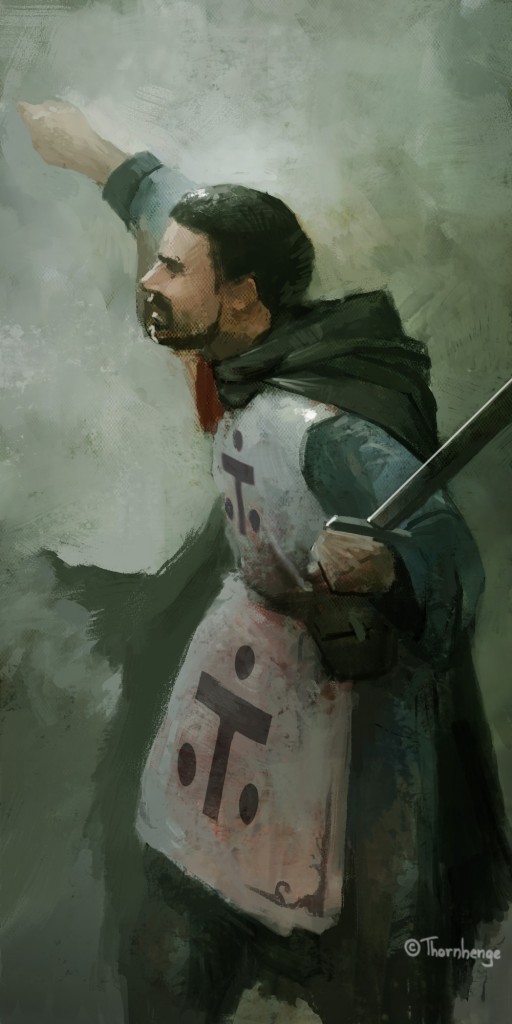 …and that’s where the images come from. Cool, huh?
…and that’s where the images come from. Cool, huh?
